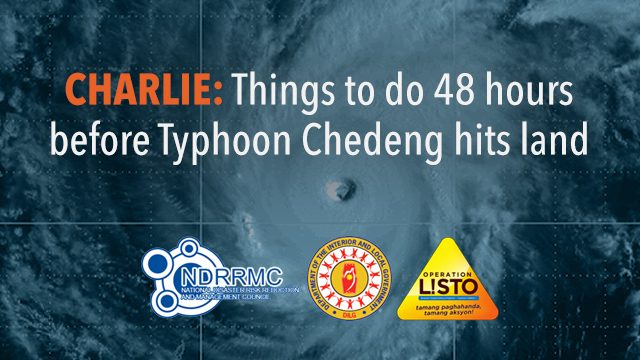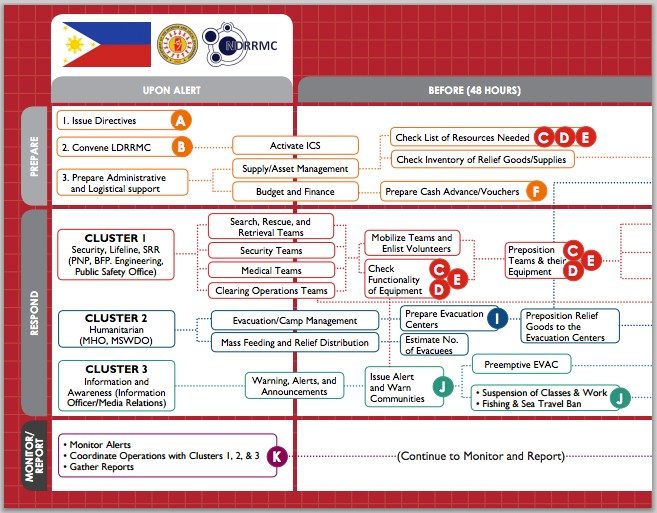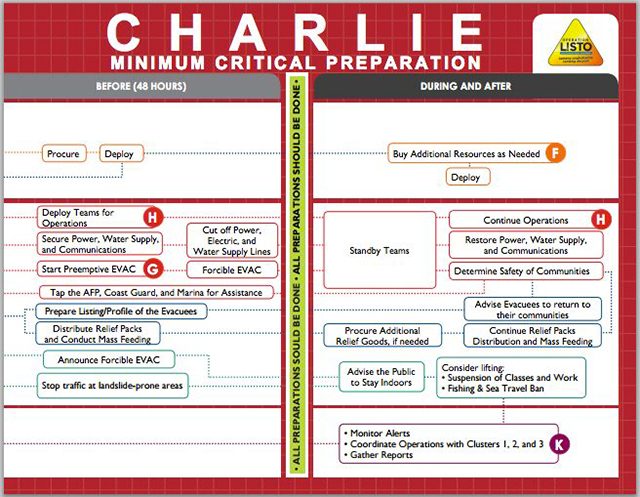SUMMARY
This is AI generated summarization, which may have errors. For context, always refer to the full article.

MANILA, Philippines – Alert level C: Charlie.
This is the set of critical preparedness actions local governments should be taking 48 hours before Typhoon Chedeng (Maysak) hits land, following Oplan Listo (Operation Plan Alert), Undersecretary Austere Panadero of the Department of the Interior and Local Government told Rappler on Friday, April 3.
Minimum critical activities that LGUs should be enforcing in affected areas include the following:
- Secure power, water supply, and communications
- Start preemptive evacuation
- Announce forced evacuation
- Prepare list of the evacuees
- Distribute relief packs and conduct mass feeding
- Stop traffic in landslide-prone areas
Vulnerable towns in Aurora and Isabela are in the process of implementing Charlie actions, according to Panadero.
“I was tracking 3 towns (San Luis, Baler, Dipaculao) in Aurora yesterday. We’ll start preemptive evacuation tomorrow, Saturday,” Panadero said.
The DILG is also closely monitoring the compliance of 5 other Aurora towns and Dinapigue, the border town of Aurora and Isabela provinces, where Typhoon Chedeng is expected to make landfall on Sunday morning, April 5.
State weather bureau PAGASA hoisted Public Storm Warning Signal No 1 over 7 provinces as the typhoon neared the country’s landmass on Friday, April 3. This means that in 36 hours, these provinces may experience winds strong enough to break tree branches, damage rice crops, and possibly even unroof some nipa and cogon houses. Flashfloods and landslides are also likely in these provinces. (READ: Chedeng maintains strength; more areas under storm signals)


Oplan Listo
Oplan Listo uses a new disaster preparedness manual first used by the DILG when Typhoon Ruby hit in December 2014. It provides mayors and other local government disaster management agencies a checklist that enumerates what should be done before, during, and after typhoons.
“The 48 hours between a typhoon’s entry into the Philippine Area of Responsibility (PAR) and its landfall is tense and busy, which can lead to errors that can be easily avoided. This checklist is the tool to minimize those mistakes that may cost lives and grave destruction to properties,” Interior Secretary Mar Roxas said in the manual’s introduction.
The manual includes flowcharts that correspond to 3 phases of critical preparedness actions – Alpha, Bravo, and Charlie. It also provides a tropical cyclone information board and reference boxes and minimum actions to guide mayors.
According to Panadero, various Alpha and Bravo preparedness actions have already been undertaken by affected LGUs, including 9 regions, 23 provinces, 71 cities, and 676 municipalities. Mayors have generally been responsive to alerts issued by the DILG.
“So far, they appreciate the guidelines, but we have yet to see how intense the actions are. We’re continuously monitoring. We’re testing in a way,” Panadero said.
It would be the first time Oplan Listo will be implemented in various areas to be affected by Typhoon Chedeng, particularly Isabela, Aurora, and Quirino.
DILG Usec Panadero: Pangatlong araw ng paghahanda. 100% of affected areas have been alerted
— Voltaire Tupaz (@VoltaireTupaz) April 3, 2015
Panadero noted that Regions II, III, and the Cordillera Administrative Region (CAR) have already been oriented about Oplan Listo as early as February.
Isabela, Aurora, and Quirino
So far, Isabela, Aurora, and Quirino have done the following actions to minimize the risk of Typhoon Chedeng, based on reports submitted by local DILG units:
- Convened Local Disaster Risk Reduction and Management Councils (LDRRMC) within 24 hours upon receiving a severe weather bulletin
- Reviewed LDRRM/Contigency Plans and Hazard Risk Maps
- Estimated number of evacuees
- Readied pre-emptive/forced Evacuation Plans
- Organized Administrative/Logistical Support Team
- Organized Search, Rescue and Retrieval Teams
- Organized Security Teams
- Organized Medical Teams
- Organized Clearing Operations Team
- Organized Monitoring and Reporting Team
- Activated 24/7 Emergency Operations Center
- Activated Incident Command System
- Conducted inventory of supplies, equipment, and stockpile of goods
- Assessed Evacuation Centers
- Placed adequate guide markers in strategic locations for evacuees and operations teams
- Informed Punong Barangays (village chiefs) of weather advisory
- Disseminated public warnings through established warning systems and weather bulletins, especially families in identified danger zones
(For coastal and island barangays) Warned fisherfolks/tourist to take precautionary measures when going out to sea
(For coastal and island barangays) Issued prohibitions for sea voyage and fishing (include rivers) and prevented people to cross in any body of water
Panadero urged the public to be alert and follow instructions of their local government officials.
“It’s simple. Listen to local governments. Track PAGASA forecasts. Follow what the local governments are advising them to do,” Panadero said.
The 1991 Local Government Code and the Philippine Disaster Risk Reduction and Management Act of 2010 mandate local government units to be at the frontline of emergency measures during disasters. – Rappler.com
Check if your mayors are taking these minimum preparedness activities that LGUs should be enforcing in areas expected to be affected by Typhoon Chedeng. Tell us how prepared your LGUs are through email (move.ph@rappler.com) or Twitter (@moveph).
Stay alert and ready with the latest weather and disaster information through Project Agos.
Add a comment
How does this make you feel?
There are no comments yet. Add your comment to start the conversation.